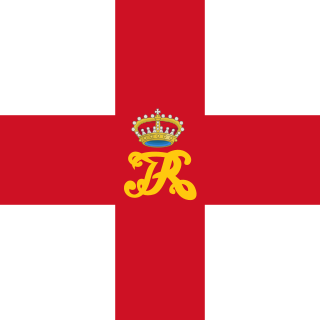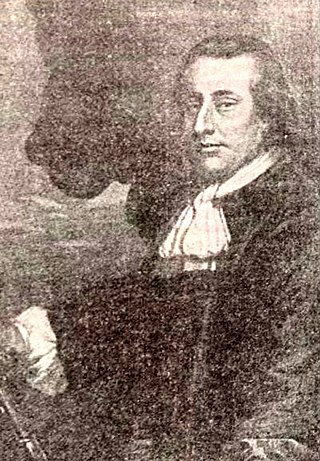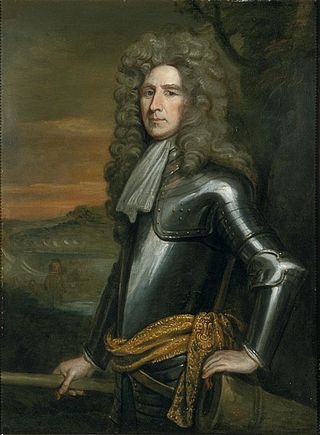Related Research Articles

The Glorious Revolution is the term, first used in 1689, to summarise events leading to the deposition of James II and VII of England, Ireland, and Scotland in November 1688 and his replacement by his daughter Mary II and her husband, who was also James's nephew William III of Orange, de facto ruler of the Dutch Republic. Known as the Glorieuze Overtocht or Glorious Crossing in the Netherlands, it has been described both as the last successful invasion of England and as an internal coup.

William III, also widely known as William of Orange, was the sovereign Prince of Orange from birth, Stadtholder of Holland, Zeeland, Utrecht, Guelders, and Overijssel in the Dutch Republic from the 1670s, and King of England, Ireland, and Scotland from 1689 until his death in 1702. As King of Scotland, he is known as William II. He ruled Britain and Ireland alongside his wife and cousin, Queen Mary II, and popular histories usually refer to their reign as that of "William and Mary".

James Francis Edward Stuart, nicknamed the Old Pretender by Whigs, was the son of King James II and VII of England, Scotland and Ireland, and his second wife, Mary of Modena. He was Prince of Wales from July 1688 until, just months after his birth, his Catholic father was deposed and exiled in the Glorious Revolution of 1688. James II's Protestant elder daughter Mary II and her husband William III became co-monarchs. The Bill of Rights 1689 and Act of Settlement 1701 excluded Catholics such as James from the English and British thrones.

The Peace of Ryswick, or Rijswijk, was a series of treaties signed in the Dutch city of Rijswijk between 20 September and 30 October 1697. They ended the 1688 to 1697 Nine Years' War between France and the Grand Alliance, which included the Dutch Republic and the Holy Roman Empire.

The Nine Years' War (1688–1697), also known as the War of the Grand Alliance or War of the League of Augsburg, was a conflict between France and the Grand Alliance, a coalition including the Holy Roman Empire, the Dutch Republic, England, Spain, and Savoy. While concentrated in Europe, fighting spread to the Americas, India, and West Africa, and it has been called the first ever world war. Related conflicts included the Williamite war in Ireland, and King William's War in North America.
This section of the timeline of United States history concerns events from before the lead up to the American Revolution.

The Grand Alliance was the anti-French coalition formed on 20 December 1689 between the Dutch Republic, England and the Holy Roman Empire. It was signed by the two leading opponents of France: William III, Stadtholder of the Dutch Republic and King of England, and Emperor Leopold I, on behalf of the Archduchy of Austria.

The Dominion of New England in America (1686–1689) was an administrative union of English colonies covering all of New England and the Mid-Atlantic Colonies, with the exception of the Delaware Colony and the Province of Pennsylvania. The region's political structure was one of centralized control similar to the model used by the Spanish monarchy under the Viceroyalty of New Spain. The dominion was unacceptable to most colonists because they deeply resented being stripped of their rights and having their colonial charters revoked. Governor Edmund Andros tried to make legal and structural changes, but most of these were undone and the Dominion was overthrown as soon as word was received that King James II had left the throne in England. One notable change was the forced introduction of the Church of England into Massachusetts, whose Puritan leaders had previously refused to allow it any sort of foothold.

Admiral Sir John Narborough was an English naval commander. He served with distinction in the Anglo-Dutch Wars and against the pirates of the Barbary Coast. He is also known for leading a poorly understood expedition to Valdivia and Patagonia in 1670–1671. In the 1680s he was involved in the scavenging of wrecked Spanish treasure ships.
Early modern Britain is the history of the island of Great Britain roughly corresponding to the 16th, 17th and 18th centuries. Major historical events in early modern British history include numerous wars, especially with France, along with the English Renaissance, the English Reformation and Scottish Reformation, the English Civil War, the Restoration of Charles II, the Glorious Revolution, the Treaty of Union, the Scottish Enlightenment and the formation and the collapse of the First British Empire.

Admiral of the Fleet George Byng, 1st Viscount Torrington,, of Southill Park in Bedfordshire, was a Royal Navy officer and statesman. While still a lieutenant, he delivered a letter from various captains to Prince William of Orange, who had just landed at Torbay, assuring the Prince of the captains' support; the Prince gave Byng a response which ultimately led to the Royal Navy switching allegiance to the Prince and the Glorious Revolution of November 1688.

The Invitation to William was a letter sent by seven Englishmen, six nobles and a bishop, later referred to as "the Immortal Seven", to stadtholder William III, Prince of Orange. He received the letter on 30 June 1688. In England, the heir apparent to the throne, James Francis Edward Stuart, had just been born to the unpopular King James II of England, and baptised a Catholic. The letter asked William, who was a nephew and son-in-law of James II, to use military intervention to force the king to make his eldest daughter, Mary, William's Protestant wife, his heir. The letter alleged that the newborn prince was an impostor.

The Spanish Armada was a Spanish fleet that sailed from Lisbon in late May 1588, commanded by the Duke of Medina Sidonia, an aristocrat without previous naval experience appointed by Philip II of Spain. His orders were to sail up the English Channel, join with the Duke of Parma in Flanders, and escort an invasion force that would land in England and overthrow Elizabeth I. Its purpose was to reinstate Catholicism in England, end support for the Dutch Republic, and prevent attacks by English and Dutch privateers against Spanish interests in the Americas.

James II was King of England and of Ireland, as well as King of Scotland as James VII, from the death of his elder brother, Charles II, on 6 February 1685. He was deposed in the Glorious Revolution of 1688. He was the last Catholic monarch of England, Scotland and Ireland. His reign is now remembered primarily for conflicts over religious tolerance, but it also involved struggles over the principles of absolutism and the divine right of kings. His deposition ended a century of political and civil strife in England by confirming the primacy of the English Parliament over the Crown.

Edward Davis or Davies was an English buccaneer active in the Caribbean during the 1680s and would lead successful raids against Leon and Panama in 1685, the latter considered one of the last major buccaneer raids against a Spanish stronghold. Much of his career was later recorded by writer William Dampier in A New Voyage Round the World (1697).

The Stuart period of British history lasted from 1603 to 1714 during the dynasty of the House of Stuart. The period ended with the death of Queen Anne and the accession of King George I from the German House of Hanover.

The English Convention was an assembly of the Parliament of England which met between 22 January and 12 February 1689 and transferred the crowns of England and Ireland from James II to William III and Mary II.
Edward Gee (1657–1730) was an English churchman, known as a controversialist, and later successively Dean of Peterborough and Dean of Lincoln.
The regnal years of English and British monarchs are the official regnal years of the monarchs of the Kingdom of England from 1066, the Kingdom of Great Britain from May 1707 to January 1801, and the United Kingdom since January 1801. The regnal calendar continues to be used in many official British government and legal documents of historical interest, notably parliamentary statutes.
References
- ↑ Europe – MSN Encarta Archived 2009-10-28 at the Wayback Machine
- ↑ O'Gorman, Frank (1997). The Long Eighteenth Century: British Political and Social History 1688-1832. London: Arnold. p. 31. ISBN 0-340-56751-1.